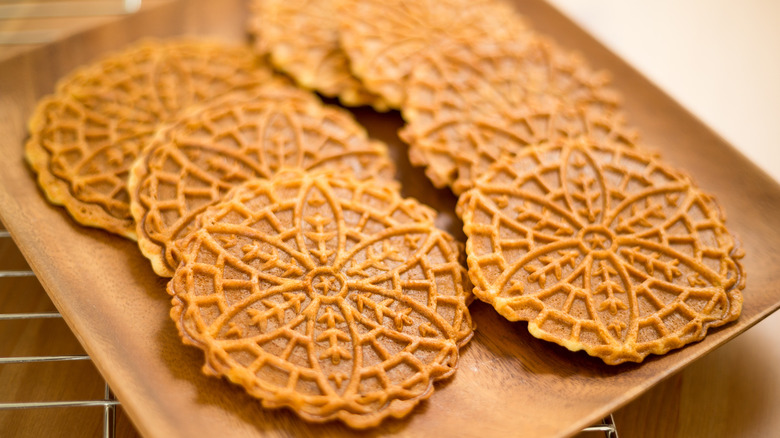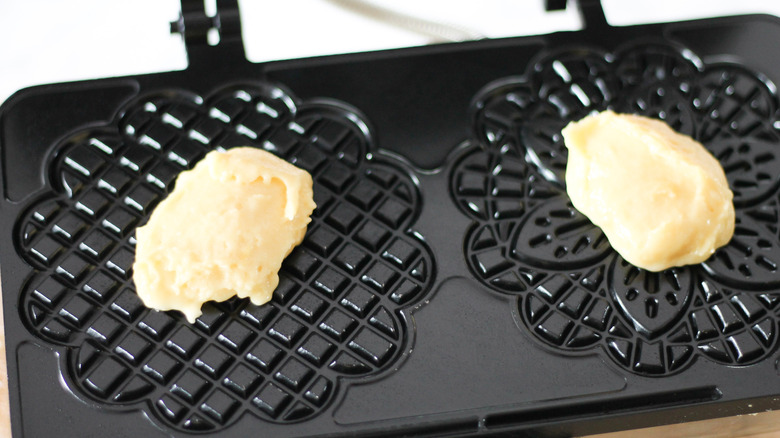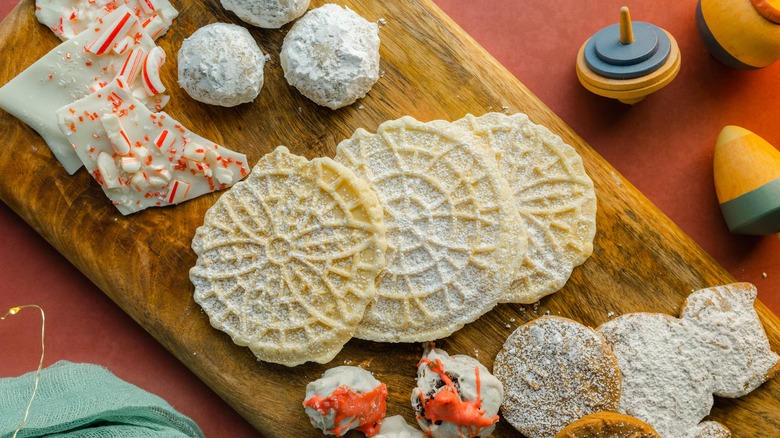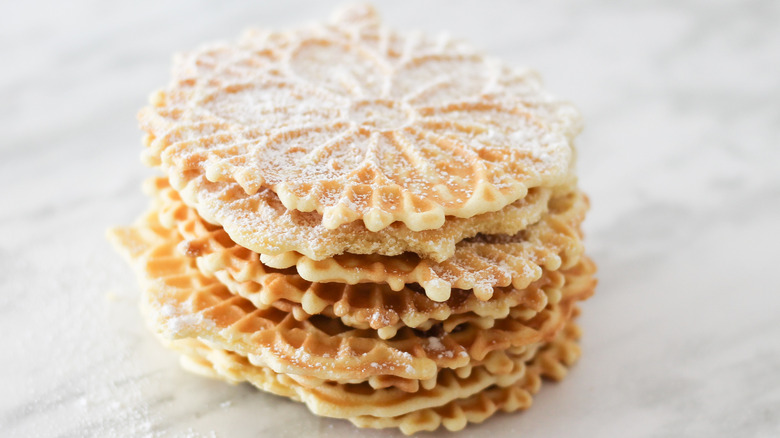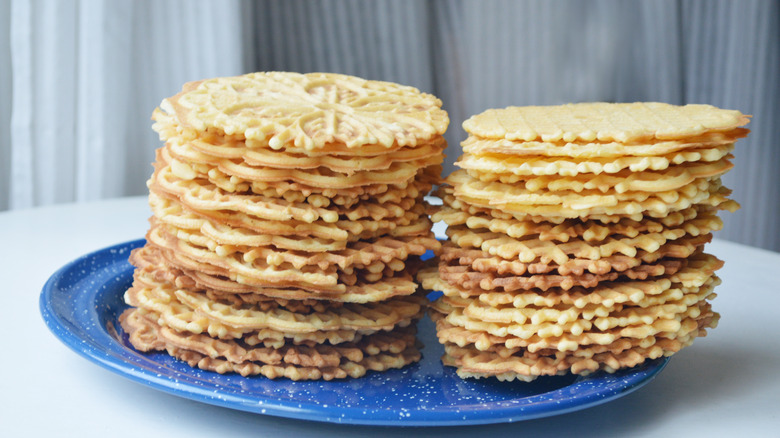Pizzelle Cookies Get Their Signature Look From A Special Appliance
Pizzelle are the Italian contribution to the world of thin, delicately flavored, crunchy waffle cookies. Literally small pizzas, "pizze" meaning flat and round, and "elle" meaning small, they're most similar to Dutch stroopwafel or Norway's krumkake. They have different names depending on what region of Italy you're in; some regions might call them nevole, ciarancelle, or catarrette but they all describe the same thing — a crispy pizzelle. They aren't baked like amaretti or ricotta cookies — they're made using a specially-designed waffle iron and a simple batter dough.
Nonnas everywhere have their own recipes, but they all result in intricately designed cookies dusted with powdered sugar or dipped in chocolate. They often appear on Italian cookie trays around Christmas and Easter, but also for any large, family-centered celebrations. If you're looking to add a touch of Italian authenticity to your next family celebration, pizzelle are it.
Pizzelle are simple treats that use pantry staples
A pizzelle recipe is a thing of simplicity, as is often the case with authentic Italian cuisine. They require just five ingredients, and pantry staples at that. All you need to create pizzelle is some sugar, eggs, flour, oil or butter, and preferred flavorings.
To actually create the cookies you'll need a pizzelle maker. This can be either one with a long handle you hold over a flame or one similar to a waffle maker. The lattice-like designs are imprinted on both plates and come in a range of shapes and images, from a simple grid to an intricate snowflake. Simply drop a tablespoon of dough on the iron, close, and bake until there's no more steam, usually less than a minute. Give a gentle dusting of powdered sugar to the cookies as they cool.
When the pizzelle come off the iron, they're quite flexible. You can mold them into shapes — rolling them into cannoli shells is an easy hack. You can also turn them into ice cream cones or bowls for mousse or other treats. You have to act quickly though, because the pizzelle will harden after it cools.
Stray from tradition and add your own flavorings to pizzelle dough
Traditional pizzelle are anise-flavored, sometimes using the extract, oil, or ground seeds. For those who are anise-averse, you will also commonly find classic vanilla pizzelle. You can also add citrus — lemon is traditional, and for something different, a light touch of orange extract will also bring some lovely freshness. A pinch of cinnamon in the dough will add some warmth, especially during the holidays. If you want to stick with Italian-themed ingredients for your Italian cookie, seek out Fiori di Sicilia, an aromatic Italian extract that contains notes of bright citrus and hints of vanilla with a floral aroma. Adding cocoa to the batter is also quite delicious, as is a bit of almond paste so common in other Italian desserts and cookies.
You can also play around with flavors — don't feel beholden to tradition. Stray from the path by browning the butter before adding it to the dough to bring some nuttiness to the pizzelle. Or try experimenting with other extracts or spices to create your own scrumptious version of pizzelle.
Pizzelle are for celebrations, and are still used in religious celebrations
Pizzelle are originally from the Abruzzo region of Italy (in the middle of the boot on the east coast), where they're known as ferratelle – named after the iron molds used to make them. The waffle irons had two plates that were locked together using the long handle and then held over a fire. Families had their own cast iron molds, passed down as wedding gifts, oftentimes embossed with family crests, initials, or names on the inner plates. Pizzelle would be made for any special occasion — weddings, celebrations, or the feast days of saints.
In regards to the possible 8th-century origins of pizzelle, the story goes that the Abruzzo village of Colcullo was snake-infested, and San Domenico chased them out of town. To celebrate, the people of the town made pizzelle. To this day, they're used in the procession of a statue of San Domenico wrapped in live snakes on his feast day on August 8. The village of Salle also lays claim to pizzelle. They hold a festival celebrating the monk Beato Roberto da Salle in July, when residents hang pizzelle from windows and tree branches as an offering to the monk.
You can find pizzelle makers on the internet
If you're ready to experiment with making pizzelle, you'll need a pizzelle iron or maker. You can easily find them on Amazon where you can get one for $40 — and Walmart has them available on its website for around the same price. Some restaurant supply stores might even be able to help you in your search. If you want to seek out a vintage pizzelle iron with its patina and funky designs, poking around antique stores or eBay would be a good idea. Even your nonna's attic might be a good place to start.
If cooking or baking isn't your thing or you're short on time but still want some traditional Italian vibes for your next celebration, you can buy the cookies. A simple search for your local Italian bakery or Italian import goods shop should reveal where they're available. And you can find pizzelle at your local Wegmans or Whole Foods in a pinch.
